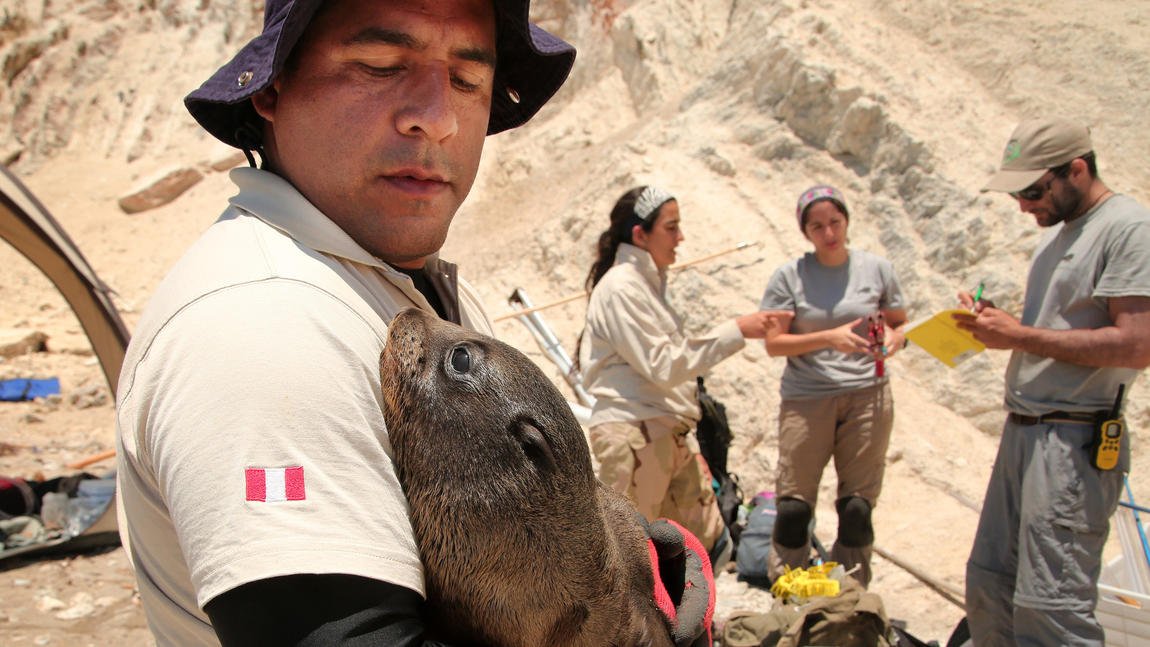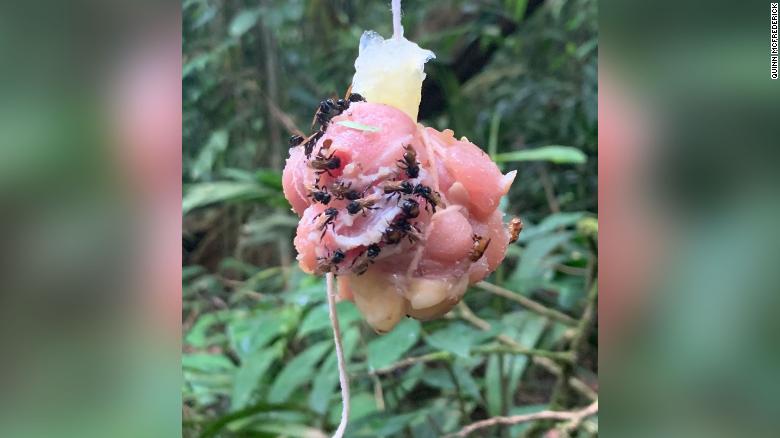
ON a sun-baked beach some 4,000 miles from the Brookfield Zoo clinic where he works, Dr. Mike Adkesson crept over rocks and bones, kelp and bird carcasses in search of a male sea lion. The steady wind carried the odor of guano and fish.
When he found the best candidate a few steps from the shoreline’s pounding waves, the veterinarian fired a dart gun and, in about eight minutes, the 410-pound animal was in a very deep sleep.
What ensued over the next hour resembled a mix of invasive medical exam and NASCAR pit stop. Eight people descended on the sea lion and took samples of blood, urine, fur and blubber, among other substances. They checked the animal’s eyes, heart rate and weight, measured and tagged its fins. Adkesson even plucked a whisker and pulled a tooth.
Before they finished, two of the researchers glued a transmitter on the sea lion’s head to track its movement via satellite.
“He’s going to wake up feeling like about five bucks,” one crew member cracked.
Called Peru’s Galapagos by some, Punta San Juan is one of the world’s richest marine ecosystems, a place that offers a staggering, rare concentration of species in a landscape that looks like the driest cliffs of Arizona, if Arizona bordered the Pacific Ocean.
It’s also a 133-acre coastal reserve that has become a central part of Adkesson’s life and a crucial piece in the mission of the Chicago Zoological Society, which operates Brookfield Zoo, to spread conservation awareness internationally.
That work is unfolding on the outskirts of a dusty mining and fishing town where corporate investment, large-scale infrastructure projects and tourism have converged. Economic prosperity is expected to follow. As all that occurs, a troubling question emerges: Will prosperity come at the expense of Punta San Juan?
The Chicago Zoological Society and Brookfield Zoo are attempting to navigate those complicated circumstances, working to protect and enhance the influence of an ecological gem while preserving cordial ties with a community hungry for a better life.
Illinois’ Pacific Ocean advocate
This coastal region of Peru is among the most arid on the planet. In many places, it’s taupe and almost lunar.
But anyone who reaches the rocky beaches and sheer cliffs of Punta San Juan sees swarms of marine mammals and seabirds clustered along the shore. The cold, deep waters of the Pacific Ocean in this area are rich with plankton — the base of marine food webs. Punta San Juan, a peninsula, was walled off from humans starting around the 1940s to maintain the spot for harvesting guano for fertilizer.
About 6,000 of Peru’s 25,000 endangered Humboldt penguins reside at Punta San Juan, where they sometimes gather in clusters of 100 or more.
The reserve and its 18 beaches also are home to an estimated 5,000 of the country’s 20,000 Peruvian fur seals, experts estimate, and at least 12,000 South American sea lions. Both species sun themselves by the dozens on many of the shoreline rocks.
And waves of seabirds — an estimated 500,000 Guanay cormorants, Inca terns, Peruvian boobies, pelicans and other species reside at Punta San Juan — rest on sand-colored ridges, turning them black.
How and why Brookfield Zoo is working here centers primarily on Adkesson, 36, a native of Decatur in central Illinois. At the age of 9, he enrolled in a children’s program at the city’s Scovill Zoo, and he stayed there in one form or another through his doctorate work in veterinary medicine at University of Illinois at Urbana-Champaign.
After he earned that degree, Adkesson heard about a postdoctorate opportunity, through the St. Louis Zoo, to conduct research on the health of penguins at Punta San Juan. Since childhood, Adkesson had been fascinated by penguins. He figured on spending two weeks here. That was in 2007.
But Punta San Juan bowled him over.
“It’s just such an absolutely amazing place,” Adkesson said in mid-November, on his 15th visit. He sat on a balcony overlooking a cove at Punta San Juan at dusk. Seabirds and fur seals on the rocky beach below squawked and howled. “There’s so much wildlife, it’s just breathtaking.”
On his most recent trip, he was accompanied by veterinarians and scientists from the St. Louis Zoo, the University of Illinois, the Florida Institute of Technology and the National Marine Mammal Foundation. Adkesson coordinated a grueling, five-day regimen of fieldwork.
Adkesson said his first visit to Punta San Juan showed him, among many things, “all the other areas (besides penguins) that needed attention and all the opportunities for making a stronger conservation program.”
He returned twice more for the St. Louis Zoo, another long-term supporter of Punta San Juan, then took a job as an associate veterinarian at Brookfield, where he had worked while a vet student at the University of Illinois. Today Adkesson, as vice president of clinical medicine at the zoo, is in charge of the animals’ medical care.
In Brookfield, which had been supporting work at Punta San Juan financially since the mid-1990s, Adkesson knew he had found a place with ample resources and a priority to expand conservation.
He pressed his case to ramp up efforts at Punta San Juan.
The result: Brookfield has sent teams of researchers to Punta San Juan to assess the health of fur seals, sea lions and a variety of seabirds, in addition to the original work on penguins. The institution also has broader goals of making Punta San Juan a model for 32 similar sites in Peru and, eventually, a global model for responsible marine wildlife management.
“No institution can do everything,” Adkesson said, but Brookfield’s mission, its history with this rare natural place and the opportunity to have a wide and lasting effect made Punta San Juan an obvious candidate for the institution’s focus, he added.
“It seems as almost a poster child or anchor for an entire concept of marine conservation,” Adkesson said.
Progress comes to Marcona
Looming over Punta San Juan’s rare ecosystem is what many would consider the encouraging recent past and near future for San Juan de Marcona, commonly known as Marcona.
Originally a sleepy fishing village, Marcona grew in the 1950s and ’60s, when a U.S. company started an iron mine about 20 miles outside the village and acquired acres surrounding the town. Today a Chinese steel company runs the mine and, like the U.S. enterprise did, owns much of the land in Marcona.
Marcona’s population stands at an estimated 16,000 — up from about 11,000 five years ago — Mayor Ivan Torres said. He expects his town to continue growing, in part because of a new transcontinental highway connecting Marcona with Rio de Janeiro, and a Peruvian-Korean mining company’s plans to build a mine 22 miles from town in 2017.
The company, Marcobre, expects to create 3,000 construction jobs and about 900 permanent mining jobs, its spokesman said.
Also, 11 wind turbines have come to the coast near Marcona, with plans for a total of 100. Construction of a hospital is scheduled to begin next year, and the Peruvian government has approved what’s being called a “megaport” for Marcona, although no funding exists for the project.
Beyond that is the anticipated uptick in tourism, a trend occurring throughout Peru.
Torres said he, the country’s environmental ministry, Punta San Juan representatives and the local artisanal fishing guild are working on a tourism plan for the region.
Attractions include dunes for ATVs and motocross, wide beaches and natural rock formations, a reserve that features condors and Punta San Juan, where Torres said he envisions “an attractive tourism center with a lot of activity” and video screens with real-time monitors showing what the animals are doing.
But he and others say they want to preserve Punta San Juan.
Elena Conterno, president of a leading Peruvian industrial fisheries organization, said a University of British Columbia analysis that ranked Peru first in sustainability among 53 countries’ fisheries demonstrates that the organization recognizes the economic importance of a healthy marine ecosystem.
During a break from a series of competitive runs called the Marcona Wind Trail, a spokesman for Marcobre mining — sponsor of the event — said Punta San Juan could be the third point in a tourism triangle that includes Machu Picchu and the Nazca Lines, sprawling, ancient etchings in the ground of a monkey, bird, spider and other forms about 50 miles north of Marcona.
Whatever tourism plan is created, it must keep Punta San Juan undisturbed, spokesman Marco Balcazar said.
“We don’t want the people — tourists — taking a selfie with the penguins,” he said. “That’s not the way.”
Building bridges with Disney’s help
To ensure Marcona’s economic coming of age doesn’t imperil Punta San Juan, Brookfield is building a grass-roots environmental movement. That involves creating conservation awareness in a largely impoverished region where people are preoccupied with day-to-day survival.
To establish that awareness, Brookfield started in 2010 by bringing informal education programs to a school attended by many local fishermen’s children, and using concepts from the institution’s Hamill Family Play Zoo. Representatives from Punta San Juan took them for tours at the preserve or to local beaches.
“It’s all just anchored around getting those children to appreciate the natural world, and wildlife, and nature,” Adkesson said. Instilling that affection for nature in children typically leads to changes in adults, he added.
The effort got a boost in late 2013, when Brookfield obtained the first of what would be three one-year grants of $25,000 each from the Disney Worldwide Conservation Fund, which allowed Brookfield to expand and enhance its outreach. The zoo also hired a community liaison from Marcona, Miluska Elguera, 32, who leads guided tours three times a month, gives presentations to community groups and organizes beach cleanups for schoolchildren.
One morning, while the field researchers were catching fur seals and seabirds, Elguera showed up at Ricardo Palma School, where she regularly visits, and tried to get the attention of 28 rambunctious fifth-graders.
Elguera clapped rapid-fire and asked the children about what they had learned from her last visit. Then she handed out quiz sheets with multiple-choice questions — what does Punta San Juan do? What’s a marine reserve? Which of these animals live in Punta San Juan?
After the students handed in their quizzes, Elguera asked a battery of true/false questions and directed the students to suggest ways to protect the environment.
“Don’t throw rubbish!” one child called. “Cloth bags!” said another.
On another day, she gathered nine teenagers at a beach, where they sifted the sand to find bits of microplastic and talked about its impact when ingested by fish the children eat.
“This is part of our lives,” said Javier Villafuerte, 13. “It’s important to appreciate what we have here because we’re surrounded by it.”
3 unlikely partners
While Adkesson is a more recent champion of Punta San Juan, the person everyone points to as its matriarch is zoologist Patricia Majluf. Without her, many say, Punta San Juan would be unprotected and ragged.
Like Adkesson, Majluf got involved somewhat randomly — as a college student looking to do research in 1979. She was planning on going to another site, a formally designated preserve. But when Majluf spoke with a man issuing visitor permits for preserves, he suggested the guano reserve called Punta San Juan.
“It kind of blew our minds,” Majluf recalled of that first visit, when she saw thousands of seals, penguins and seabirds. “The place was teeming with wildlife.”
Besides Punta San Juan’s seclusion, an essential factor in the creation of those wildlife-rich conditions was guano — seabird droppings.
Guano, it turns out, was an extremely effective fertilizer so valued in the U.S. and Europe — particularly in the mid-1800s — that disputes over it sparked anti-U.S. riots in Lima and a war pitting Peru and Chile against Spain.
In the early 1900s, Peru established a guano reserve system that effectively barred people from dozens of islands, islets and coastal areas. At Punta San Juan, the government built a 12-foot concrete wall that stretches for nearly a mile. The system allowed millions of seabirds to congregate, while providing abundant sources for harvesting fertilizer.
That protection, and the distance that Punta San Juan’s peninsula juts into those cold, rich waters, made it perhaps Peru’s most attractive refuge for other marine wildlife.
Majluf realized immediately the rare ecosystem she had found and decided to devote her research to it. Her early efforts, supported by the Wildlife Conservation Society, helped protect Punta San Juan while ecosystems at many of the other reserves were largely unmonitored and languished.
By 2001, Majluf began pushing the government to convert the 33 guano reserves into nature preserves and limit guano harvests.
About the same time, her work earned Majluf almost hero status in the eyes of a young woman studying to become a biologist, Susana Cardenas.
Born in Peru during the 1982-83 El Nino weather pattern, Cardenas was 5 when she came to New York City with her parents, who were pursuing graduate degrees at Fordham University. The family lived in Queens for several years until her parents completed their studies and returned to Peru, where Cardenas finished high school and began studying biology at Cayetano Heredia University in Lima.
“I was one of those save-the-planet kids,” Cardenas said.
When she’d heard about Majluf’s research, Cardenas said jokingly that she began stalking the respected zoologist.
“I started bugging her, chasing her down and she would say, ‘no,'” Cardenas recalled, laughing. “She was just doing her thing,” trying to change the government’s policy on guano reserves.
Cardenas persisted, finding a way to get to Punta San Juan as a student in 2003, then worked as a research assistant there before she left in 2008 to work on her master’s degree in zoology at University of British Columbia in Vancouver.
A year later, the Peruvian government converted Punta San Juan and the other reserves into “marine protected areas.” Officials say Majluf’s work was crucial.
Throughout her efforts to protect Punta San Juan, Majluf enlisted zoos and other institutions, including the Chicago Zoological Society, to support the reserve and conduct research there.
“She’s a very amazing woman and an inspiration to conservationist efforts,” said Adkesson, who met Majluf on his first visit to Punta San Juan in 2007 and began working with her then.
Three years later, in 2010, Majluf called the college student who had been stalking her.
“Susana, you have to come back,” Cardenas recalled Majluf telling her. “The vets want to chase after fur seals and I’m too old for this.”
Cardenas came back in 2010, met Adkesson that year and the two started conducting field research. A year later, the Chicago Zoological Society hired Cardenas as its Peru representative.
Today, she is director of the Punta San Juan Program, works alongside Adkesson in the field and consults with Majluf regularly.
“I see in her my succession,” said Majluf, who now works as a vice president at Oceana, an international nonprofit focused on protecting and restoring the oceans. “She’s been amazing.”
Adkesson played a crucial role, too, Majluf said. His research and “constant requests for support for his expeditions … kept the interests of the people of the zoo,” who increased that support, she said.
“Between Susana and Mike,” Majluf said, “they’ve revived the whole activities at Punta San Juan.”
Long days, cold-water nights
The heart of those activities is the fieldwork, which Adkesson coordinates on twice-a-year trips to Punta San Juan.
Workdays start about 8 a.m., when researchers ride in a Toyota pickup for about a half-mile to a green, cinder-block house in Marcona that doubles as the team’s lab. They load gear — dart guns, a heart monitor, oxygen tanks, hoses, sample tubes, coolers and ice to carry samples and a portable gas anesthesia machine — and return to the preserve.
They drive near the spot where that day’s research will be done, unload and trek to the work site, typically a shadeless cove. Adkesson breaks from the group and stalks an animal.
Once they finish working on an animal, Adkesson uses a syringe to administer drugs that revive the creature, then moves on to find the next subject.
They repeat the process four or five times a day, working until about dusk. Then the researchers return to the “Guanera,” their concrete barracks where the host is a lame, friendly dog named Con Hambre — “with hunger” in Spanish. The Guanera lacks electricity or hot water, but some on the team shower anyway. Some eat.
Then the crew returns to the green house, where hot showers are available, and process the day’s samples. That work can run until almost midnight.
The intensity of that effort is why, Adkesson says, he caps fieldwork at four to five days.
On a Saturday after they completed five days in the field, many in the crew attended a festival organized around the Marcona Wind Trail.
Dr. Jenny Meegan, a veterinarian from the National Marine Mammal Foundation, led a group clearing trash from the beach. Brookfield postdoctorate researcher Megan Watson found herself wearing a limp penguin costume with a torn right shoulder, an item Punta San Juan often uses to promote the reserve at children’s programs.
Michael Jackson’s “Billie Jean” pulsated from speakers on a stage, and Watson moonwalked, backward. Even one of the mutts roaming Marcona paused to watch.
The next day, the research team had cleared out of the Punta San Juan barracks and scattered toward home. Sixteen chairs were set up a couple of steps inside the main entrance. Elguera was ready to give another guided tour.
Only two people showed up, although about 60 had attended a tour coordinated earlier that day by a mining company.
Elguera forged ahead, explaining the Punta San Juan project and its role in organizing beach cleanups in which children collected 4,400 pounds of rubbish in four hours.
She talked about seabirds, showed pictures, displayed a stuffed toy penguin, then handed out binoculars and led the visitors to a lookout point.
The final stop on the tour was an observation shed — adorned by a Marcobre logo — at the edge of a cliff.
“Yes, it can be discouraging,” she said of the meager turnout. “But it’s part of our development.”
[Source:- Chicago Tribune ]












